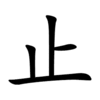止
| ||||||||
Translingual
| Stroke order | |||
|---|---|---|---|
 | |||
Alternative forms
Note that 龰 may also be a component of the radicals 疋 (𤴓/𤴔), 辵 (辶), 走, and 足 (⻊/𧾷).
Han character
止 (radical 77, 止+0, 4 strokes, cangjie input 卜中一 (YLM), four-corner 21100, composition ⿱⿰丨⺊一 or ⿻上丨 or ⿻⺊丄)
- Kangxi radical #77, ⽌.
Derived characters
Descendants
- と (Hiragana character derived from Man'yōgana)
- ト (Katakana character derived from Man'yōgana)
References
- KangXi: page 573, character 24
- Dai Kanwa Jiten: character 16253
- Dae Jaweon: page 961, character 23
- Hanyu Da Zidian: volume 2, page 1435, character 3
- Unihan data for U+6B62
Chinese
| simp. and trad. |
止 | |
|---|---|---|
Glyph origin
| Historical forms of the character 止 | ||||||
|---|---|---|---|---|---|---|
| Shang | Western Zhou | Warring States | Shuowen Jiezi (compiled in Han) | Liushutong (compiled in Ming) | ||
| Bronze inscriptions | Oracle bone script | Bronze inscriptions | Chu Slip and silk script | Qin slip script | Small seal script | Transcribed ancient scripts |
 |
 |
 |
 |
 |
 |
 |
| Characters in the same phonetic series (止) (Zhengzhang, 2003) | |
|---|---|
| Old Chinese | |
| 祉 | *kʰlɯʔ |
| 址 | *kjɯʔ |
| 止 | *kjɯʔ |
| 趾 | *kjɯʔ |
| 芷 | *kjɯʔ |
| 沚 | *kjɯʔ |
| 阯 | *kjɯʔ |
| 齒 | *kʰjɯʔ |
| 紕 | *be, *pʰi, *kʰjɯʔ |
Pictogram (象形) – a footprint, originally meaning "foot". The derivative 趾 (OC *kjɯʔ) refers to the original meaning. Compare 手 (“hand”). Note that in oracle script, composed of 3 toes and a sole.
Compare to 夊, 夂, which have similar shape in oracle script, but pointing down (toe pointing right), and 𡕒 (as in right side of 舛, roughly ヰ, toe pointing left), hence different evolution.
Pronunciation
Definitions
止
Antonyms
- (stop): 始 (shǐ)
Compounds
Derived terms from 止
|
|
|
Japanese
Readings
Compounds
- 遏止 (asshi)
- 一乗止観院 (ichijōshikan'in)
- 駅止 (ekidome)
- 襟止 (eridome)
- 依止 (eji)
- 乎古止点 (okototen)
- 核抑止 (kakuyokushi)
- 鎌止 (kamadome)
- 川止 (kawadome)
- 諫止 (kanshi)
- 客止 (kyakudome)
- 休止 (kyūshi)
- 競業避止 (kyūgyōhishi)
- 拒止 (kyoshi)
- 挙止 (kyoshi)
- 禁止 (kinshi)
- 鞍作止利 (kuratsukurinotori)
- 車止 (kurumadome)
- 止観 (shikan)
- 止観業 (shikangō)
- 止汗剤 (shikanzai)
- 止観十乗 (shikanjūjō)
- 止血 (shiketsu)
- 止止不須説 (shishifushusetsu)
- 止瀉剤 (shishazai)
- 止宿 (shishuku)
- 止水 (shisui)
- 止痛 (shitsū)
- 車輪止 (sharindome)
- 臭気止 (shūkidome)
- 終止 (shūshi)
- 笑止 (shōshi)
- 止揚 (shiyō)
- 止痢剤 (shirizai)
- 真言止観 (shingonshikan)
- 進止 (shinshi)
- 止住 (shijū)
- 止動方角 (shidōhōgaku)
- 制止 (seishi)
- 静止 (seishi)
- 咳止 (sekidome)
- 沮止 (soshi)
- 阻止 (soshi)
- 体言止 (taigendome)
- 中止 (chūshi)
- 丁丁発止 (chōchōhasshi)
- 血止 (chidome)
- 停止 (teishi)
- 底止 (teishi)
- 天台止観 (tendaishikan)
- 止木 (tomegi)
- 止句 (tomeku)
- 止相場 (tomesōba)
- 止針 (tomebari)
- 止偏 (tomehen)
- 止弁 (someben)
- 廃止 (haishi)
- 波止場 (hatoba)
- 船止 (funadome)
- 閉止 (heishi)
- 摩訶止観 (makashikan)
- 明鏡止水 (meikyōshisui)
- 黙止 (mokushi)
- 山止 (yamadome)
- 雪止 (yukidome)
- 容止 (yōshi)
- 抑止 (yokushi)
- 乎古止点 (okototen)
- 魚鳥止 (gyōchōdome)
- 動止 (dōshi)
- 防止 (bōshi)
Korean
Vietnamese
Han character
止 (chỉ)
- This term needs a translation to English. Please help out and add a translation, then remove the text
{{rfdef}}.
This article is issued from
Wiktionary.
The text is licensed under Creative
Commons - Attribution - Sharealike.
Additional terms may apply for the media files.